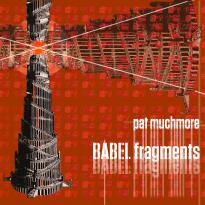 |
 |
|||||||
 |
 |
|||||||
 |
||||||||

NEW CD AVAILABLE!!!

Available at:
The followup to Anti-Social Music's recording of my music, Fracture: The Music of Pat Muchmore, is finally here, and it's called BABEL fragments. Here's a description I wrote for press purposes:
About innova's first album of Pat Muchmore's music, Anti-Social Music's 2010 disk entitled Fracture: The Music of Pat Muchmore, critics said:
"The chaos lies somewhere between John Zorn's Naked City skronk and a nightmarish noir score, a little bit organ-grinder meets meat grinder. But there's more to this than wild, antagonizing dissonance."
—Mia Clarke, Time Out Chicago
"Fracture: The Music of Pat Muchmore is a thrilling, exhilarating, 70-minute journey through music many would qualify as mad or chaotic. Arguing that would be a moot point, but the fact is that, in time, this haphazardness—themes cut short, mood swings, brutal interpolations—becomes structural and produces its own meaning. … [It] is definitely not an easy listen, but it rewards as much as it shocks, and it sustains deeper analysis, revealing … a unique personal universe."
—François Couture, All Music Guide
"Fracture is the musical equivalent of a box of chocolates, with none of the chocolates being the real sweet, milky pieces. No sir, this is the dark, hard stuff, and if you prefer your candy undiluted and strong that way, Anti-Social Music has a Whitman's Sampler for you."
—Pico, Something Else
Now, in his new album, Muchmore explores the shift from that album's overriding focus on the verb "fracture," to the fallout of the noun "fragment." BABEL fragments still has many moments of active breaking, such as the total rending of the musical texture that ends the album, but it also features enigmatic, evocative fragments of musical ideas that gesture toward a broken world beyond the destruction. The album is also fixated on the apparent impossibility of true communication. The frailty of language is investigated both in the constantly-shifting translations of significant phrases in the lyrics of the second piece—often using poor machine translations and shifting violently between ancient and modern languages—as well as in the use of disparate notational traditions ranging from the well-understood Japanese shakuhachi notation to the only mostly-translated notation of ancient Greece to the barely-deciphered cuneiform notation of Sumeria and Babylon. The 32 tracks of BABEL fragments frantically search for intercommunication as a bulwark against disintegration, but, ultimately, fail. As John Jeremiah Sullivan said of the pre-Hispanic petroglyphs of America, "It's dangerous to read something when you can't really read it. And we can't. Try to see it. That's hard enough."
The album features several musicians from the first album: violinist Jean Cook (of ASM and Beauty Pill), violinist Hubert Chen (of ASM and the New York Repertory Orchestra) and saxophonist/clarinetist Ken Thomson (of Bang on a Can All-Stars, Asphalt Orchestra, Slow/Fast and gutbucket). The second piece features coloratura soprano Kamala Sankaram (of ASM, Bombay Rickey, the Wooster Group and the Tri-Centric Orchestra). Muchmore himself plays cello throughout, along with some occasional trombone, vocals and electronics. Unconventionally recorded and mixed at the predominantly rock- and heavy-metal-focused studio Spaceman Sound, BABEL fragments was produced by Tom Tierney (of Tidal Arms, Julie Christmas and Suncruiser), who has recorded, mixed and/or mastered for artists and bands like Netherlands, Candiria and Kid Millions. Together, these six musicians navigate works in which rupture has counterintuitively become structural; and those structures are themselves revealed to be the eerie ruins of something larger and, in the end, untranslatable. The true meaning lies somewhere in between the shattered remains.
The first piece is a collection of eleven "short stories" for string trio, called f(f(4))[Kr]5s118d1:}{:Fr.I.a–k. Here's a video in which I discuss both it (in the second half) and the third piece on the album. Also, you can read more about the piece here.
The second piece is a five-movement work for soprano, cello and electronics with a super fancy title that I often simplify as BABEL(maya). For the REAL title, go to this page, or watch this video:
The third piece is similar in structure to the first, but it's for solo scordatura cello. More info here, and there are also a few scraps of info in that first video above.
The final piece is very much a companion piece to the second. It also has a ridiculous title, but I often just call it SHESHACH(maya). Once again, I made a video explaining it, and there's also a page with tons more info.